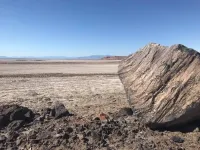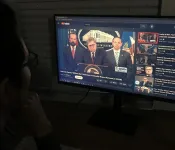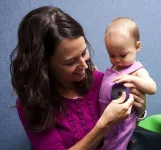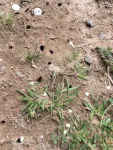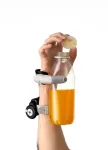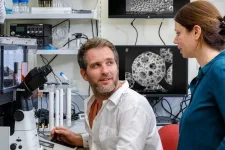(Press-News.org) The Gilbert Family Foundation has awarded data scientists in the Department of Biomedical Informatics (DBMI) at the University of Colorado School of Medicine $1.2 million to develop a microscopy assay and analysis pipeline for organoids derived from patients with Neurofibromatosis 1 (NF1), a complex rare disease that causes tumors to grow along nerves and produces a range of symptoms.
The project will help researchers develop more treatments for the disease, says DBMI assistant professor Gregory Way, PhD, the primary principal investigator for the work.
“We're developing a new preclinical model for NF1 tumors,” Way explains. “The assay is called cell painting, which my lab analyzes all the time, but always in 2-dimensional cell cultures. With this project, we will be developing the assay for the first time with NF1 patient derived organoids, which have a whole bunch of different cell types. Organoids are more dynamic and thought to more closely model patient environments than individual cell lines.”
Foundational firsts
One treatment currently exists for patients with NF1, which occurs about once in every 3,500 births and primarily manifests in childhood and continues into adulthood, but experts say the drug, Selumetinib, only works for a small percentage of NF1 patients and many eventually relapse.
“There is a huge need for more treatments,” Way says. “We think that this assay is going to be helpful for several reasons. It's going to give us a lot of different types of information that we can't get from the omics data, and it's also going to be an important assay for drug screening.”
Way and his team are working with Alice Soragni, PhD, at the University of California Los Angles who will create the organoid systems from cutaneous neurofibromas (cNF), plexiform neurofibromas (pNF) and malignant peripheral nerve sheath tumors (MPNSTs). These will be the foundation of the new assay. After data is collected, Sara Gosline, PhD, at the Pacific Northwest National Lab in Washington will analyze the omics data, making sure the mutations and the process of growing the organoid hasn’t created significant genetic drift between the patient and organoid.
“This approach, developed uniquely by our multidisciplinary team, will revolutionize drug screening for NF1 and accelerate the development of precision medicine therapies for NF1 patients,” Way explains.
Over the course of four years, Way’s team will collect data and develop an image analysis framework for extracting high-content information from the patient-derived organoids. In the end, the new assay could be great news for NF1 researchers and patients of the devastating disease.
The researchers will screen hundreds of therapeutically relevant drugs in the organoids derived from NF1 patients and nominate treatments that promote cell health with low toxicity specific to each patient.
Deep learning and beyond
Computer algorithms will allow researchers to identify organoid features that are not visible by the human eye that affect how the organoids respond to drugs.
“We’ll develop and use deep learning-based algorithms to process and analyze the image data, and while it’s not indispensable, it does make our lives much easier,” Way says. “As part of the development of this framework, we will compare various approaches for analysis, and that’s what makes deep learning our best bet.”
Work from the Way Lab will be open source from the beginning of the project, allowing other researchers to apply the framework to other organoid models. In addition to patients with NF1, Way can see a future where the framework changes the world of drug screening for rare disease.
“The overarching goal is that people will use this framework, develop it, and make cell painting and this specific image analysis framework the de facto standard for precision medicine drug screening,” Way says. “There's a lot of excitement in the field for neurofibromatosis researchers and patients that this kind of initiative, made possible by the Gilbert Family Foundation, is going to start to make some progress that we haven't been able to make before.”
END
Grant funds CU project to develop novel mechanism to expand NF1 treatments
With no cure and only one treatment available to neurofibromatosis 1 patients, a new microscopy assay and analysis pipeline in development by faculty in the Department of Biomedical Informatics has the potential to change lives.
2024-05-29
ELSE PRESS RELEASES FROM THIS DATE:
A drying Salton Sea pollutes neighboring communities
2024-05-29
When desert winds stir up dust from the Salton Sea’s exposed lakebed, nearby communities suffer from increased air pollution. The deterioration coincides with reduced flows into California’s largest lake, a new research paper in the American Journal of Agricultural Economics finds.
Disadvantaged communities have been affected more than others in the areas near the Salton Sea, which has been shrinking for years, said the paper’s co-leading author Eric Edwards. He is an assistant professor of agricultural economics at University of California, Davis, who did the research while at North Carolina State University.
“We ...
Wild megalopolis: Study shows unexpected pockets of biodiversity pepper Los Angeles
2024-05-29
UCLA biologists have some good news and some bad news for lovers of urban wildlife in Los Angeles. The good news? Unexpected pockets of biodiversity pepper the city. The bad news? It will be a challenge to elevate the level of overall biodiversity of the city. Of all the major taxonomic groups studied, only snails and slugs are ‘easy’ to find in Los Angeles, probably because of the abundance of landscaping, gardens and irrigation.
The research points toward ways Angelenos — and people elsewhere — can make their city more hospitable not only to urban-tolerant species such as coyotes, but also to species that usually ...
Slugs and snails love the city, unlike other animals
2024-05-29
Most native species avoid more urbanized areas of Los Angeles, but slugs and snails may actually prefer these environments, according to a study publishing May 29 in the open-access journal PLOS ONE by Joseph Curti from the University of California, Los Angeles, and colleagues.
Urban areas continue to grow around the world, putting pressure on native species that find it difficult to tolerate the habitat changes and pollution it brings. To conserve and even increase biodiversity in cities, scientists and city planners need large-scale data on the ecological communities present, but this is time consuming and difficult to collect. Researchers used data from iNaturalist, a large ...
Ideas that cross international borders may have powerful impact on elections
2024-05-29
New simulations provide mathematical support for the theory that the spread of political ideas across international borders may have a big impact on election outcomes, and that small actions boosting a minority idea can gradually lead to global-scale political change. Jose Segovia-Martin and Óscar Rivero present these findings in the open-access journal PLOS ONE on May 29.
People in many regions around the world are increasingly exposed to international information—such as news and opinions shared via social media—allowing for the possibility of ...
YouTube’s comments section: Political echo chamber or constructive cross-partisan forum?
2024-05-29
The YouTube comments sections of politically neutral news outlets might be more conducive to cooperative, cross-partisan conversation than their liberal and conservative counterparts, according to a study published May 29, 2024 in the open-access journal PLOS ONE by Seung Woo Chae and Sung Hyun Lee from Indiana University. The study, which focused on the media response to the 2019 release of the Mueller report, found that more cross-partisan discussions took place on liberal channels than conservative ones and mainstream news outlets hosted more cross-partisan ...
Babies babble squeals and growls in clustering patterns observable from birth through the first year, suggesting this active vocal exploration is important to speech development
2024-05-29
In the first large-scale observation with human coding of infant vocalizations using all-day home recordings, babies of all ages from birth up to a year old squealed and growled in significant cluster patterns, suggesting the babies may have been actively engaged in noisemaking play and sound practice, according to a study published May 29, 2024 in the open-access journal PLOS ONE by Hyunjoo Yoo from the University of Alabama, Pumpki Lei Su from the University of Texas at Dallas, and colleagues.
In their first year of life, babies spend a remarkable amount of time vocalizing—both responding with noises to parents and caregivers, as well as self-directed babbling that could ...
The sweat bee, H. rubicundus, is less sociable in Scotland than in Cornwall, but is genetically differentiated and genetically isolated too
2024-05-29
The sweat bee, H. rubicundus, is less sociable in Scotland than in Cornwall, but is genetically differentiated and genetically isolated too
###
Article URL: https://journals.plos.org/plosone/article?id=10.1371/journal.pone.0302688
Article Title: Genetic differentiation at extreme latitudes in the socially plastic sweat bee Halictus rubicundus
Author Countries: Netherlands, UK
Funding: This work is part of a project that received funding from the European Research Council (ERC) under the European Horizon's 202 research and innovation programme (grantagreement no. 695744). RAB was funded by a Wageningen Graduate School Postdoctoral Talent fellowship and a BBSRC discovery ...
Smartphone use may help adolescents feel better - at least in the moment, finds real-time survey of US teens
2024-05-29
Smartphone use may help adolescents feel better - at least in the moment, finds real-time survey of US teens
###
Article URL: https://journals.plos.org/plosone/article?id=10.1371/journal.pone.0298422
Article Title: Real-world adolescent smartphone use is associated with improvements in mood: An ecological momentary assessment study
Author Countries: USA
Funding: This study used data from a larger project that was funded by a stand-alone research agreement between Facebook's Youth Research Fund (2018-2020, Facebook, Inc.) ...
Public have no difficulty getting to grips with an extra thumb, study finds
2024-05-29
Cambridge researchers have shown that members of the public have little trouble in learning very quickly how to use a third thumb – a controllable, prosthetic extra thumb – to pick up and manipulate objects.
The team tested the robotic device on a diverse range of participants, which they say is essential for ensuring new technologies are inclusive and can work for everyone.
An emerging area of future technology is motor augmentation – using motorised wearable devices such as exoskeletons or extra robotic body parts to advance our motor ...
Breakthrough in cancer prediction with nano informatics and AI
2024-05-29
A recent study has introduced a novel method combining nano informatics and machine learning to precisely predict cancer cell behaviors, enabling the identification of cell subpopulations with distinct characteristics like drug sensitivity and metastatic potential. This research could transform cancer diagnosis and treatment, enhancing personalized medicine by facilitating rapid and accurate testing of cancer cell behaviors from patient biopsies and potentially leading to the development of new clinical tests to monitor disease progression and treatment effectiveness.
In an important advance in the fight against ...
LAST 30 PRESS RELEASES:
Dynamically reconfigurable topological routing in nonlinear photonic systems
Crystallographic engineering enables fast low‑temperature ion transport of TiNb2O7 for cold‑region lithium‑ion batteries
Ultrafast sulfur redox dynamics enabled by a PPy@N‑TiO2 Z‑scheme heterojunction photoelectrode for photo‑assisted lithium–sulfur batteries
Optimized biochar use could cut China’s cropland nitrous oxide emissions by up to half
Neural progesterone receptors link ovulation and sexual receptivity in medaka
A new Japanese study investigates how tariff policies influence long-run economic growth
Mental trauma succeeds 1 in 7 dog related injuries, claims data suggest
Breastfeeding may lower mums’ later life depression/anxiety risks for up to 10 years after pregnancy
Study finds more than a quarter of adults worldwide could benefit from GLP-1 medications for weight loss
Hobbies don’t just improve personal lives, they can boost workplace creativity too
Study shows federal safety metric inappropriately penalizes hospitals for lifesaving stroke procedures
Improving sleep isn’t enough: researchers highlight daytime function as key to assessing insomnia treatments
Rice Brain Institute awards first seed grants to jump-start collaborative brain health research
Personalizing cancer treatments significantly improve outcome success
UW researchers analyzed which anthologized writers and books get checked out the most from Seattle Public Library
Study finds food waste compost less effective than potting mix alone
UCLA receives $7.3 million for wide-ranging cannabis research
Why this little-known birth control option deserves more attention
Johns Hopkins-led team creates first map of nerve circuitry in bone, identifies key signals for bone repair
UC Irvine astronomers spot largest known stream of super-heated gas in the universe
Research shows how immune system reacts to pig kidney transplants in living patients
Dark stars could help solve three pressing puzzles of the high-redshift universe
Manganese gets its moment as a potential fuel cell catalyst
“Gifted word learner” dogs can pick up new words by overhearing their owners’ talk
More data, more sharing can help avoid misinterpreting “smoking gun” signals in topological physics
An illegal fentanyl supply shock may have contributed to a dramatic decline in deaths
Some dogs can learn new words by eavesdropping on their owners
Scientists trace facial gestures back to their source. before a smile appears, the brain has already decided
Is “Smoking Gun” evidence enough to prove scientific discovery?
Scientists find microbes enhance the benefits of trees by removing greenhouse gases
[Press-News.org] Grant funds CU project to develop novel mechanism to expand NF1 treatmentsWith no cure and only one treatment available to neurofibromatosis 1 patients, a new microscopy assay and analysis pipeline in development by faculty in the Department of Biomedical Informatics has the potential to change lives.
